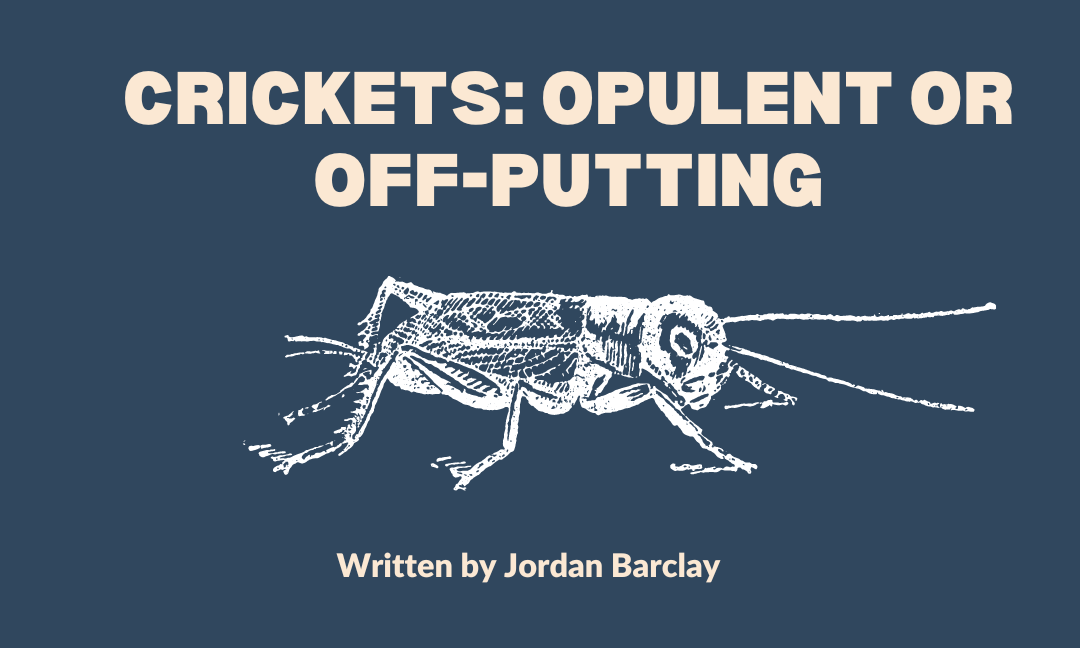Written by Jordan Barclay
Edited by Kiritika Rana
Designed by Kiritika Rana
Published by Kiritika Rana
Crickets! Really? Ugh!
It’s not as bizarre as you might think! In many regions across the world, crickets are not only a viable source of alimentation, but are even considered delicacies! With a little view back into the past, we can pinpoint why crickets may just have more of a future than you think….
Dating back thousands of years, insect consumption has been practised in various cultures throughout the world. Historical records reveal that ancient civilizations in Africa, Asia, and Latin America regularly incorporated insects into their diets. For instance, the ancient Greeks and Romans consumed insects as part of their daily meals, while indigenous communities in Mexico and Central America included edible insects such as grasshoppers and ants in their traditional recipes. Insect consumption was not limited to survival situations but also had cultural significance, with some insects being considered delicacies or aphrodisiacs. The practice of eating insects declined over time due to varying factors such as industrialization and changing food preferences; however, it is now experiencing a resurgence due to its potential environmental benefits and nutritional value.
Crickets have gained attention as an emerging delicacy due to their rising popularity and potential culinary applications. In recent years, there has been a growing interest in consuming insects as a sustainable and nutrient-rich alternative to traditional sources of protein. Among the various edible insect options available, crickets have garnered particular attention for their versatility in culinary preparations. Their mild taste and nutty flavour profile (yum!) make them suitable for a wide range of dishes, from snacks to main courses. Additionally, crickets are highly nutritious and rich in protein, vitamins, and minerals. This makes them an appealing choice for health-conscious consumers looking to diversify their diets and reduce their carbon footprint. The increasing availability of cricket-based products on the market further contributes to their status as a rising delicacy with potential long-term viability in the culinary world.
This discussion will explore the nutritional value of crickets, focusing on their protein content and quality, essential vitamins and minerals, as well as healthy fats and amino acids. Crickets are known to be a rich source of protein, containing all essential amino acids required for human health. Additionally, they provide various essential vitamins and minerals necessary for optimal bodily functions. Moreover, crickets offer a good source of healthy fats and amino acids that contribute to overall health and well-being.
Vitamins and minerals are essential components of a healthy diet, and their presence in edible insects contributes to their potential as a nutritious food source. Edible insects, such as crickets, have been found to contain various vitamins and minerals that are important for human health. For instance, crickets are rich in vitamin B12, which is crucial for the formation of red blood cells and maintaining proper nerve function. They also provide significant amounts of iron, which is necessary for oxygen transport within the body. In addition, crickets contain zinc, magnesium, calcium, and phosphorus – all essential minerals involved in various physiological processes. The presence of these vitamins and minerals in edible insects makes them a valuable dietary option that can help meet daily nutritional requirements.
Healthy fats and amino acids are important components of a balanced diet, and their presence in edible insects, such as crickets, makes them a potential source of valuable nutrition. Crickets are rich in healthy fats, including omega-3 and omega-6 fatty acids. These fats play crucial roles in various physiological processes, such as supporting brain function and reducing inflammation. Additionally, crickets contain essential amino acids that the human body cannot produce on its own. Amino acids are the building blocks of proteins and are necessary for the growth and repair of tissues. Consuming crickets can provide individuals with a well-rounded profile of essential amino acids required for optimal health. Therefore, incorporating crickets into one’s diet can offer a unique opportunity to obtain these vital nutrients that contribute to overall well-being.
Now even with all the great benefits of cricket consumption, you still may find it hard to accept the general idea of eating an insect. This is what can be colloquially called the “yuck factor”. How do we overcome the yuck factor? Well, it can be done through culinary innovation! If we can promote creative recipes that incorporate cricket products in familiar dishes, we can help facilitate the transition for those who are skeptical. Another way would be to encourage renowned chefs to experiment with crickets to help bring the insect into mainstream knowledge.
Crickets have been utilized in various culinary applications such as protein bars and cricket flour. Their incorporation into these products allows for the creation of diverse and innovative dishes that challenge traditional notions of food. The potential uses of crickets in culinary practices are vast and intriguing, offering a unique sensory experience for those willing to explore alternative sources of nutrition. Add ground crickets to your stir fry sauces to provide a subtle umami taste! Or sprinkling roasted or seasoned crickets atop salads or soups to add a crunchy texture and visually striking element!
These examples demonstrate the versatility and potential appeal of incorporating crickets into various culinary creations, providing an opportunity for individuals to broaden their palates while embracing sustainability in food production.
In conclusion, the consumption of crickets presents a potential solution to various global challenges. Despite initial misconceptions and ethical considerations, their nutritional value is undeniable. The culinary innovation surrounding cricket-based dishes has the potential to not only provide a sustainable food source but also cater to diverse tastes. As society progresses towards a more environmentally conscious future, exploring alternative protein sources like crickets becomes increasingly important. Ultimately, embracing the idea of eating crickets may be necessary for both our well-being and the health of the planet.

